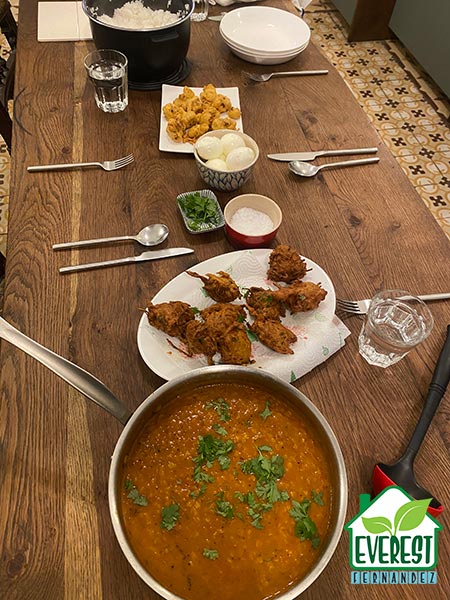A Hydroponic Grower’s Guide to Cultivating Pusa Jwala Chilies
Even if your love for chilies is only a fraction of mine, Pusa Jwala deserves a top spot on your list of cultivars to grow indoors. Growing up in the Midlands and later travelling across the Indian subcontinent, I discovered the versatility and distinctive heat of this popular Indian hot pepper (Capsicum annuum). (In the UK the Pusa Jwala is more commonly known as the “curry chilli”.) Today, I cultivate Pusa Jwala under high-intensity full-spectrum LED grow lights in my climate-controlled basement using hydroponics. Here in southern France, where fresh chilies are a rare commodity, growing my own Pusa Jwala has become both a necessity and a passion.
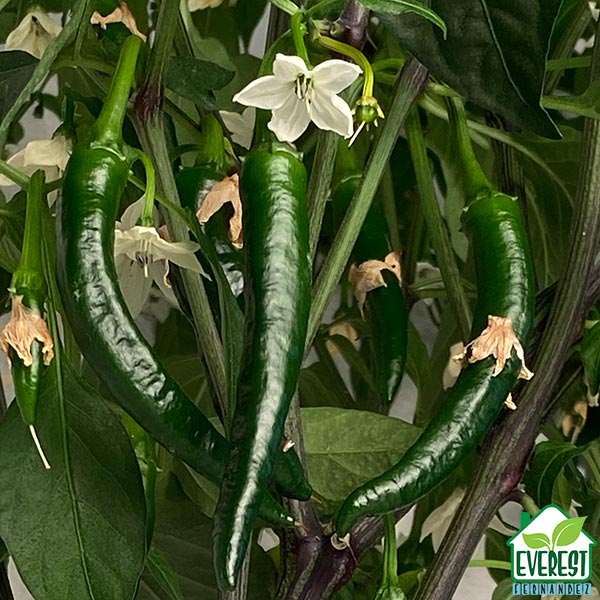
In this grow guide, I share detailed insights on nutrient management, environmental control, and advanced techniques—drawing on personal experience and research. Whether you are an experienced hydroponic grower or simply looking to enhance your indoor cultivation, this guide is designed to help you get the very best out of Premium Pusa Jwala seeds, available throughout Europe, France, and the UK.
My Journey with Pusa Jwala
Growing Pusa Jwala indoors has been a journey of discovery. I still recall the early days: despite sourcing high-quality seeds, the Pusa Jwala took longer to germinate than some of the other varieties in my collection. However, this initial delay was soon eclipsed by a remarkable burst of vigour—it was the first to flower, beginning even while still in my propagation tent, long before its peers showed any signs of bud formation.
Living in southern France, where fresh chilies are hard to come by, I have come to appreciate the uniqueness of Pusa Jwala even more. Its young fruits are subtly warm and develop a richer heat as they mature from dark green to a deep, vibrant red. Patience is rewarded here, whether your aim is to dry the peppers, produce a fine powder, or achieve high-quality seed propagation.
Pusa Jwala Cultivation Setup and Methodology
Hydroponic System and Propagation
My indoor cultivation system is designed to maximise both yield and quality. I begin by germinating Pusa Jwala seeds in Grodan stone wool cubes, placed inside a HOMEbox Vista (formerly known as a Clonebox, measuring 1.2m x 0.65m x 1.2m) propagation tent maintained at 25–30°C with high humidity.
I pre-soak the stone wool cubes in pH adjusted reverse osmosis water with 0.25ml/L of Ecothrive Trace and a tiny amount of calmag (calcium magnesium supplement). The EC ends up around 0.2 mS and the pH is 5.5.
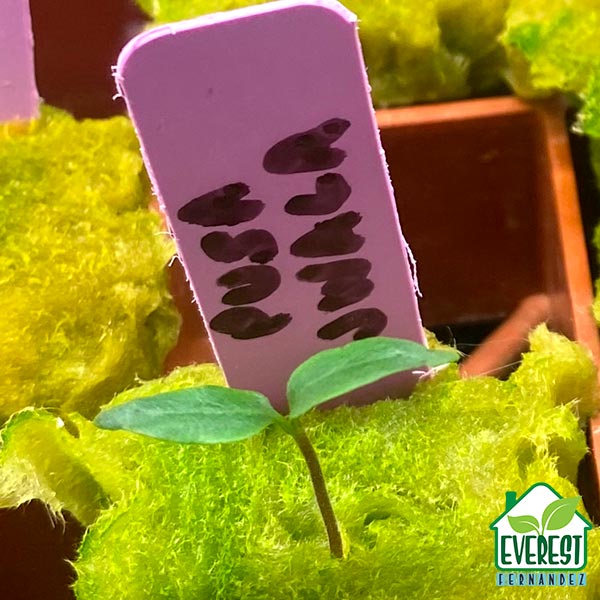
The tent is lit by 2 x 100W Daylight LED bars, initially set to 25% intensity using external dimmers and gradually increased to 100% over 6–7 weeks. Although the germination is slower than with some other cultivars, once the seedlings emerge they are transplanted into Grodan HUGO blocks as soon as they begin to “cry out” for more nutrient solution. When the plants require more than one “dip” per day, it’s time to make the move.
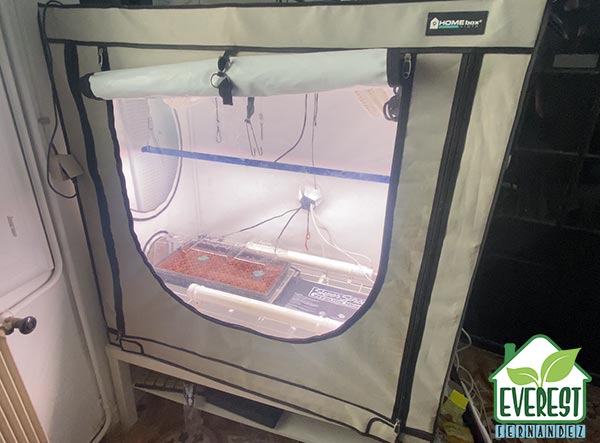
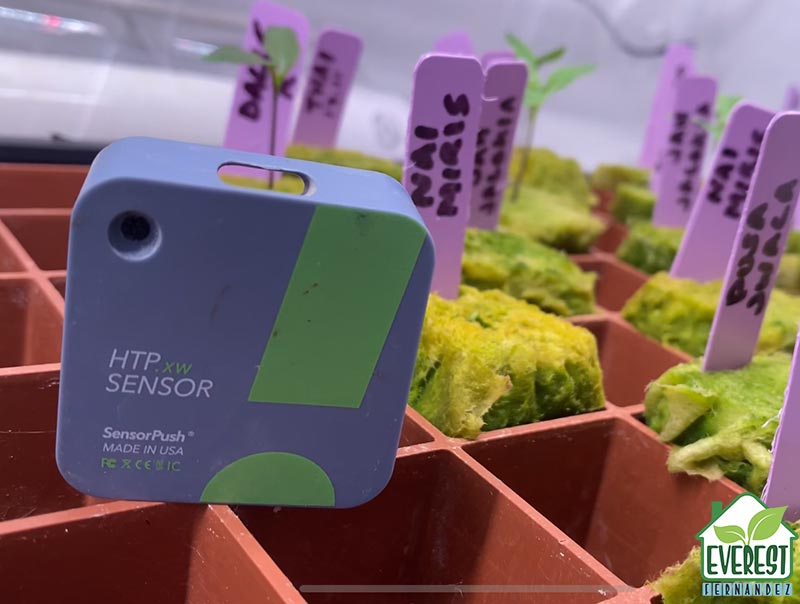
After a few weeks of establishment in the HUGO blocks, the plants are then transferred into my main grow room under a full-spectrum, multi-array LED system (typically 600–720W). My hydroponic setup is relatively straightforward—a 4’ x 4’ grow tray that holds sixteen Grodan HUGO 6” x 6” x 6” blocks—but demands daily attention due to the varying water needs of different chilli varieties. For this run, I opted for manual irrigation to best accommodate these differences.
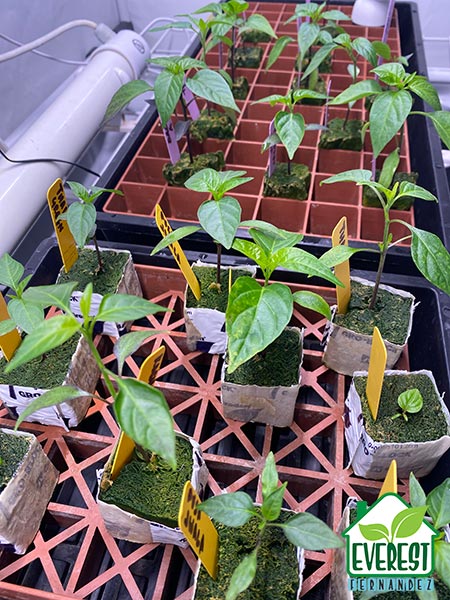
Environmental Conditions and Lighting
Pusa Jwala thrives under bright, consistent full-spectrum lighting. I position the plants in the brightest corner of my grow room, using a combination of top-mounted LED panels and two 330W side LED lights.
This arrangement provides the intensity needed for vigorous vegetative growth and early flowering.
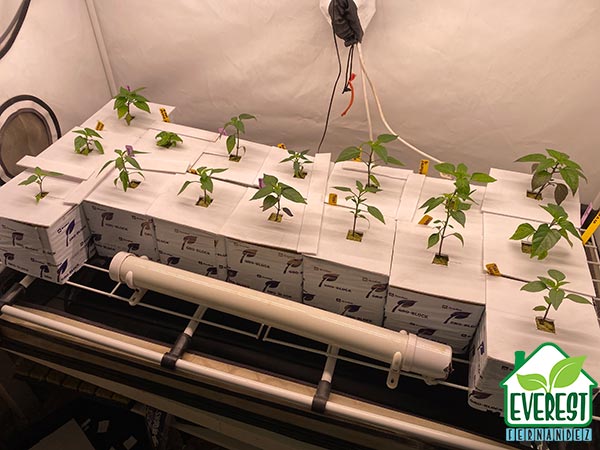
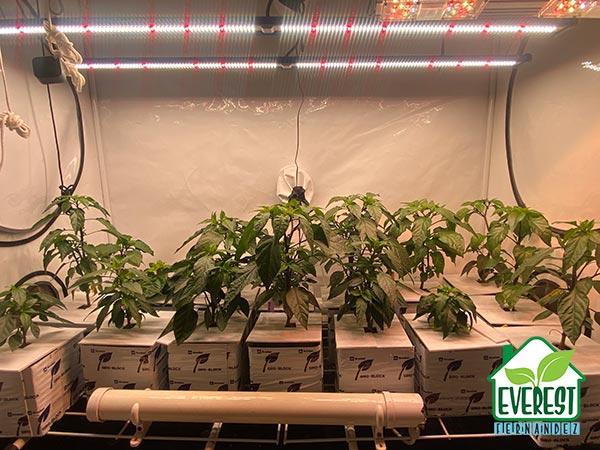
Although chilies are not photoperiodic, I reduce the light period to 12–13 hours during the flowering phase to further encourage fruit set.
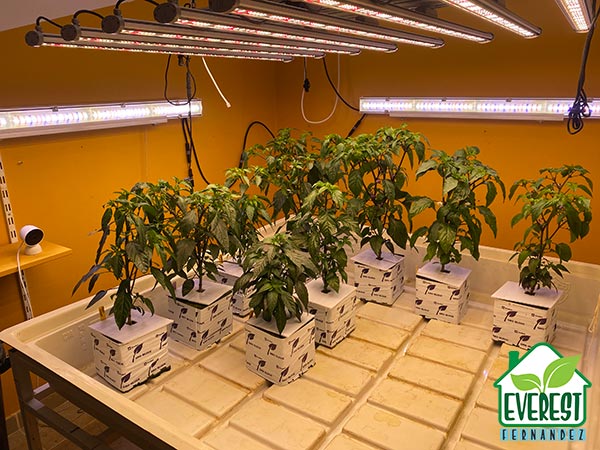
To ensure that the plants receive the right amount of light at each stage, I follow this target light intensity schedule:
| Growth Stage | Weeks | PPFD (µmol/m²/s) | Light Source & Settings |
| Seedling Stage | 1–2 | 100–200 | 2 x 100W Daylight LEDs at 25% intensity |
| Early Vegetative | 3–4 | 250–400 | 2 x 100W Daylight LEDs increased to ~50% |
| Mid Vegetative | 5–6 | 400–600 | 2 x 100W Daylight LEDs at 75–100% intensity |
| Pre-Flowering | 7–8 | 600–800 | 720W multi-array LED at 50–75% intensity |
| Flowering & Fruiting | 9–12+ | 800–1000 | 720W multi-array LED at full power |
Maintaining stable temperatures is equally critical. My side-lights add extra heat, and the room’s AC is set to keep daytime temperatures above 28°C, switching to a dry mode at night to avoid excess moisture. Perfect daytime temperatures for me are 26–28°C and, at night, it’s easy and natural for my basement to call to 17–18°C. (I run my lights during the day.)
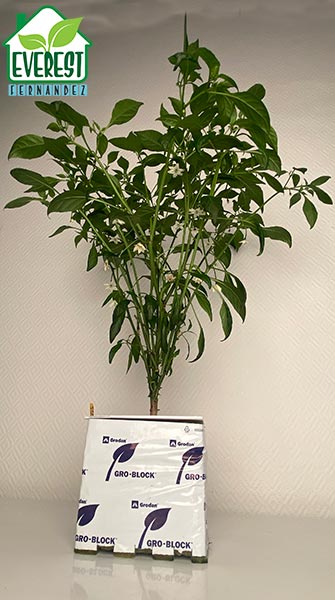
Nutrient and Irrigation Management
Maintaining Ideal EC and pH Levels
Under the high light conditions, I manage the nutrient solution carefully to maintain an input EC between 2.0 and 2.5 mS/cm with a pH around 6.0. However, I have observed that the run-off EC can quickly spike to 3.0–3.5 mS/cm—especially when I employ dry-back techniques to encourage generative growth.
To counter this, I make several deliberate adjustments:
- Nutrient Adjustment:
I lower the nitrogen content and boost phosphorus and potassium levels by using a lower-strength base nutrient (Plagron Hydro A+B) and supplementing with CalMag (added first) and a PK/13 booster (added last). This adjustment ensures a balanced nutrient supply that promotes flowering and fruit development. - Managing Run-Off:
When I notice the run-off pH increasing—a sign of high nutrient uptake—I give the root zone a flush with a milder nutrient solution (EC 1.6–1.8 mS/cm). This helps prevent salt build-up without compromising growth. - Monitoring Tools:
Precision is essential, so I use Grodan GroSens root zone monitors to keep track of water content, EC, and temperature directly from my smartphone. These monitors are really designed (and priced) for professional growers. They help me to ensure that the root zone moisture does not drop below 50%. For best results, I schedule three to four small, ‘shot-sized’ irrigation events per day, aiming for about 20% run-off relative to the total feed solution applied.
Insights from the IARI Breeding Programme
A significant part of Pusa Jwala’s reputation stems from its robust pedigree, developed at the Indian Agricultural Research Institute (IARI). The IARI breeding programme used classical techniques such as mass selection and backcrossing to develop cultivars with high yield and strong disease resistance.
Historical Techniques and Disease Resistance
If etymology and language is your thing then you’ll be interested to note that the name “Pusa Jwala” literally translates to “Pusa Flame” in Hindi—a reference to its georgraphic origins and its wonderfully addictive heat.
Diving a little deeper, the word “Jwala” originates from the ancient language of Sanskrit and translates directly to “intense flame”—this appositely reflects the chili’s bright red pigment when the tapered, wrinkled pods are fully mature.
This cultivar is most commonly grown in regions like Gujarat and Maharashtra, where the climate and cultivation practices have long favoured robust chilli production.
IARI’s efforts also focused on imparting resistance to several common diseases, including:
- Phytophthora Root Rot: A fungal threat prevalent in conditions of high moisture, which the genetic resistance helps mitigate even in hydroponic setups.
- Chilli Leaf Curl (Begomoviruses): A viral disease that has historically impacted yields; the resistant genetics ensure a better chance of maintaining healthy plants.
- Bacterial Wilt: Another serious concern in traditional cultivation that Pusa Jwala’s pedigree helps overcome.
For indoor growers, these traits provide reassurance that the robust genetics of Pusa Jwala can offer additional protection even in a controlled environment.
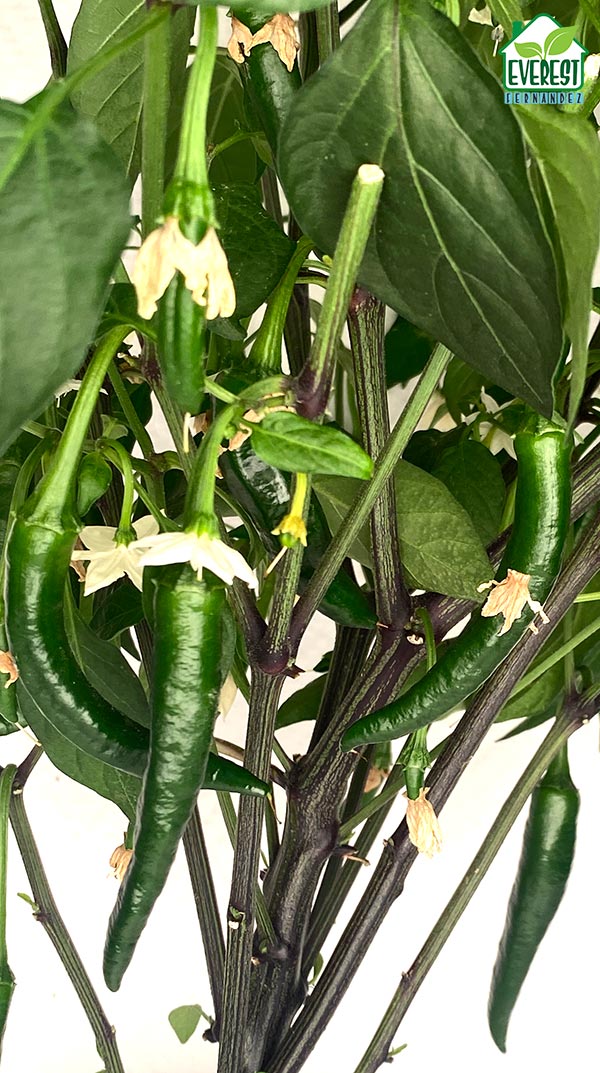
Comparative Advantages: A Research-Based Perspective
Research and practical experience suggest that while some cultivars may germinate faster, Pusa Jwala consistently outperforms in key areas relevant to indoor hydroponic systems.
- Early Flowering and Fruit Set:
Although its germination may be slower than that of cultivars like Pusa Sadabahar or Bangalore Torpedo, once established, Pusa Jwala is invariably the first to flower. This early generative transition is essential for maximising production in a space-restricted indoor setting. - Gradual Build-Up of Heat:
The heat in Pusa Jwala starts off subtle, allowing for a refined flavour profile during early use. As the fruits mature from dark green to red, the capsaicin levels build gradually—a beneficial trait whether you plan to use the chillies fresh, dry them for powders, or produce high-quality seeds. - Compact Growth Habit:
Unlike some varieties that may become tall and unwieldy under full-spectrum lighting, Pusa Jwala maintains a fairly compact form. This makes it particularly well-suited to indoor hydroponic cultivation, where space and uniformity are critical.
These attributes, supported by research, highlight why Pusa Jwala is the preferred choice for those seeking a premium, indoor hydroponic chilli cultivation experience.
Practical Tips for the Indoor Grower
For those looking to replicate my success with Pusa Jwala, here are some practical tips:
- Monitor Your Nutrient Solution:
Use reliable devices such as the Grodan GroSens monitor to track EC, pH, and root zone moisture. Regular adjustments help prevent nutrient overload and salt build-up. - Adopt Multiple Irrigation Events:
Manual irrigation may require three to four small ‘shot-sized’ waterings per day. Aim for about 20% run-off relative to your total feed volume to ensure optimal nutrient uptake. - Adjust Nutrient Formula as Needed:
During the generative phase, lower nitrogen levels while increasing phosphorus and potassium. This strategy manages rising run-off EC and promotes healthy flowering and fruit development. - Patience is Essential:
Understand that while the slow germination of Pusa Jwala may test your patience, the early flowering and robust fruit set ultimately yield superior results. Allow the fruits to mature fully—from dark green to red—to fully develop their flavour and heat. - Embrace the IARI Legacy:
Remember that the strong genetic resistance developed at IARI offers an extra layer of security against common diseases such as Phytophthora root rot, chilli leaf curl, and bacterial wilt.
Pusa Jwala is a premium chilli cultivar that combines a storied pedigree with exceptional performance in indoor hydroponic systems. Its name—rooted in its origins at IARI in Pusa, with “Jwala” meaning “intense flame”—reflects both its cultural heritage and its gradually developing heat. While it is most commonly grown in Gujarat and Maharashtra, its robust characteristics have made it a favourite among growers worldwide. Living in southern France, where fresh chilies are scarce, I have found that Pusa Jwala offers both an unmatched flavour and reliability under controlled conditions.
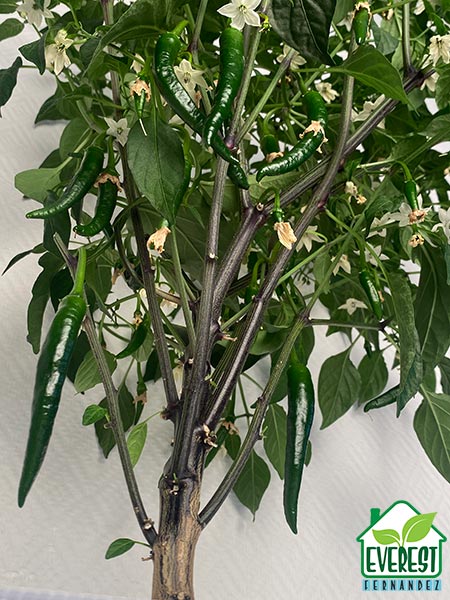
For anyone looking to enhance their indoor hydroponic garden with a chilli that flowers early, maintains a compact growth habit, and gradually builds an ideal heat profile, Pusa Jwala stands out as a definitive choice. With Premium Pusa Jwala seeds available for growers in Europe, France, the UK, and worldwide, you can be confident in cultivating a crop that marries tradition with modern indoor technology.
Happy growing, and may your indoor garden flourish with the steady, fiery promise of Pusa Jwala!
